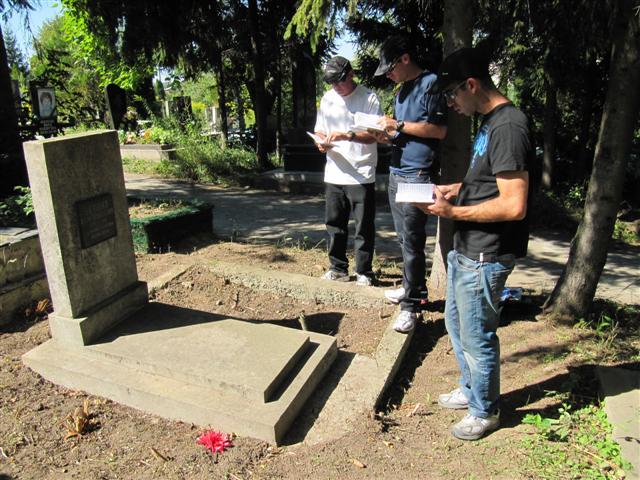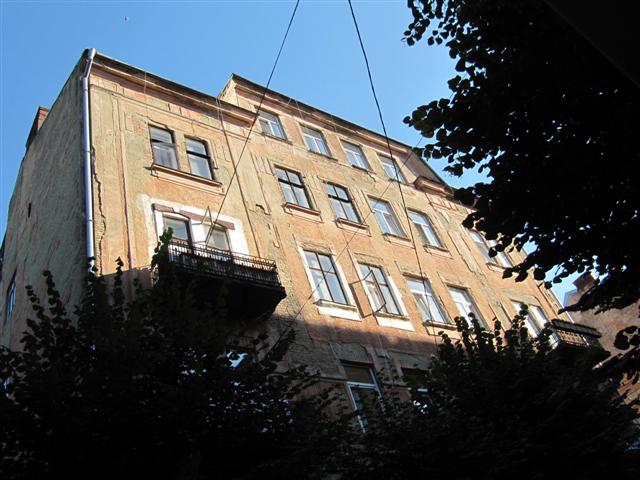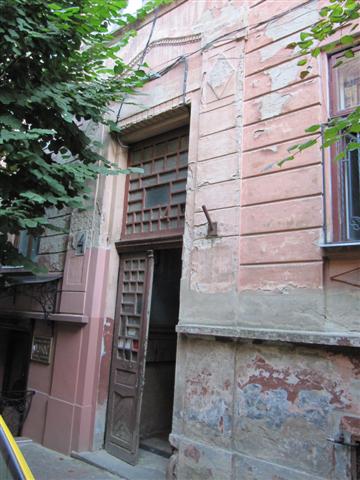
|
Rik From the Desk of Erna Rubin (1927-2014) |
|
| Home | Czernowitz 2010 | Galati 2010-A | Galati 2010-B | Poland 2014 | My Childhood Heroes | About Erna Rubin in Hebrew |
| The Secret Language | Uncle Herman and His Friends | Mommy is Here | The Fundraising |
|
From early childhood I have heard the name Cernauti in Romanian or Czernowitz in German (Chernivtsi in Ukrainian), mentioned many times by my mother, Erna (Ella) Rubin (1927-2014), with great love and nostalgia for the pre WWII Austro-Hungarian Czernowitz - her hometown in which my grandfather (my mother's father) Leon Bendit was buried there in 1981. Because my mother's native language was German, henceforth I'm going to refer to her hometown by the German name "Czernowitz" - the way she knew it, nevertheless today the city is located in Ukraine and mostly known by Chernivtsi. For clarification: Until 1918 Czernowitz was a part of the German speaking Austria-Hungary, and from 1918 to 1940 a part of Romania. Erna was born, in 1927, formally in Romania (her parents were born in Austria-Hungary) but her culture was still German.
Leon and Yetti Bendit (Klinger) married in Czernowitz around 1926 and divorced around 1933. In 1948 Yetti immigated to Israel and remarried. Leon married again in Czernowitz before WWII, had a baby son, David, who perished in the holocaust when sent with his parents to Transnistria. After the war Leon returned to Czernowitz and remained there for the rest of his life. By profession Leon and Yetti were fashion tailors, Yetti for women and Leon for men. Yetti had a Sewing workshop employing around 8 workers in Czernowitz. So, we (my sons Udi, Ron and me) decided to make the trip to Czernowitz in order to visit the grave of my grandfather Leon Bendit and to try to locate my mother's house which was on Maria Theresiengasse 6 (now Tcheliuskintsiv).
Czernowitz (Chernivtsi) today is the administrative center of Chernivtsi Oblast (province) in southwestern Ukraine. The city is situated on the upper course of the Prut River, a tributary of the Danube, in the northern part of the historic region of Bukovina, which is currently divided between Romania and Ukraine. Population 240,600. As a cultural and architectural center, Czernowitz was dubbed Little Vienna, Jerusalem upon the Prut, or the European Alexandria. Historically, the city was very multinational. From 1870 to the Second World War Jews were the biggest population group of Czernowitz. Czernowitz once had a Jewish community of over 50,000, less than a third of whom survived World War II. In August 1941 Romanian military dictator, Ion Antonescu, ordered the creation of a ghetto in the lowland part of the city, where 50,000 Bukovina Jews were crammed; two thirds of which would be deported to Transnistria (among them my mother and her family), where the majority perished. The Romanian mayor of the city, Traian Popovici, persuaded Antonescu to raise the number of Jews exempted from deportation from 200 to 20,000 and by that saved their lives. For this Popovici was awarded the Righteous Among the Nations title by the state of Israel. After World War II many Jews emigrated to the then Palestine because of the hardships of life after the War. Following the collapse of the Soviet Union in 1991, the majority of the remaining Jewish population emigrated to Israel and the United States. Many well-known Jewish figures were born or were residents of the city: novelist Aharon Appelfeld; singer, actor and cantor Josef Schmidt (1904 – 1942); Israeli Minister of Finance, Ze'ev Sherf (1904-1984) and others. First of all, I called the Jewish community and the Habad organization (tel +380372585280) in Czernowitz and was referred to a local Jew by the name of Leonid Lipchitz (tel +380372528468) whose job was to locate old graves. The location costed us $30 and the cleaning a $70 more since the grave was in a mess. We hired a local guide and driver since in Ukraine is not easy to manage with English or other Western European languages. In Czernowitz there is a Romanian minority and it's possible to go around with Romanian (which I possess) but better to hire a local guide which costed us €50 per day besides lodging and living expenses. To my astonishment, I was told by Leonid that my grandfather Leon was not buried in the Jewish cemetery but rather in the general one along with Christians, since this was the communist policy of the time. Moreover, his name was Russified accordingly and his name written in Cyrillic letters was no more Leon Bandit, But Leon Bandit Davidovich (son of David, according to the Russian tradition), since his Father's first name was David. As could be seen in the picture below, an empty plot is attached to the grave. Is it reserved for his second wife and maybe this is an indication that she's still alive? In any case, this should be further investigated by approaching the city hall of Czernowitz. We also asked Leonid to find David Bandit's (my grand grandfather which was buried in Czernowitz or Sadagora) grave, and this would cost us an additional $100 if he finds it because this is an old grave and difficult to locate, but we are willing to pay. From my mother we knew that the last address of Leon's in Czernowitz was on Isopescul (now Kordubi) Street but we haven't the exact No, so this issue should be also further investigated.

My mother lived on Maria Theresiengasse 6 (now Tcheliuskintsiv) and we set out to find it. Basically, Austro-Hungarian Czernowitz was build around Ringplatz (now Tsentralna Ploshcha) the city's central piazza. From here spun out a few streets among them Herrengasse (now Kobilianskoy) that lead to Maria Theresiengasse. With the help of Leonid we followed this path and shortly arrived at my mother's street. Here we had some difficulties locating No. 6 since the numbering of the buildings were slightly changed and many buildings resemble. But with the help of some hospitable neighbors and a clarification phone call to my mother in Israel we were able finally to locate the building.


The Stars of David located on one of the domes of The University of Czernowitz (built in the 1870s) are a real enigma. Some say that this is out of respect that the university’s architect felt toward the local rabbi. But this is doubtful since the university, as an Orthodox Christian institution, was probably not willing to endorse a Jewish symbol. The other explanation speaks about the idea that the Star of David is not necessarily a Jewish symbol but rather a universal one, used by different religions and cultures, including Christianity, during history. But even if that’s the case, it does not make sense since the Star of David is strongly associated with Judaism from the 16th century. We stayed in Czernowitz for two days since our trip to Czernowitz was a part of our voyage to Romania and our schedule was strict. We felt that two days dedicated for Czernowitz was less than desirable and we surely would come back in the future not only to go further with our mentioned above investigations but also to visit some ghetto towns that my mother and her family were deported to in Transnistria, not far from Czernowitz, where many perished - Shargorod and Mogilev. To sum it up: old Czernowitz is a real jewel of beauty of Austro-Hungarian architecture and is worth visiting without any particular reason. |



